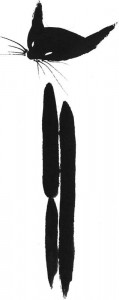Sumi-e – the path of black ink
Sumi means black ink and e stands for path, street, road as well as art of painting. The Freestyle Art of Ink Painting consists of powerfully hushed, quickly dashed off lines. It expresses the Zen-belief, that enlightenment can come at the speed of a flash of lightning. What is only indicated or even omitted is often more important and more expressive than what is actually painted. The austerity of means, the reduction to the essential is the heart of Sumi-e painting.
“Great perfection must appear insufficient
in order to become infinite in its impact.
Great abundance must appear empty
in order to become inexhaustible.”
Tao-Te-king
Zen-Buddhism came from China during the 12th century and influenced life and culture in Japan. Not only Samurais, but also artists and scholars were decisively impressed by Zen. Famous Zen-buddhists like Josetsu, Shubun, Sesshu, Miyamoto Musashi and Hakuin were masters of the Art of Ink Painting. The early Zen-artists, who were closely connected to the Taoism, expressed their mystical view of life through Sumi-e painting.
Throughout the social development of Japan, in the struggles of the emperors and counter-emperors for power, the Zen-monasteries often became important cultural headquarters. They preserved tradition and further developed it within the meaning of their spiritual thinking.
This way Sumi-e, this high skill, was preserved for us and modern minimalism with westerly impressions not last has its roots in the Japanese culture.
The „Path of Black Ink“ is not painting in the sense of the word, but more a „sketch in black and white“. The idea of an object is expressed with only the most significant lines. The “dancing brush” executes every line quickly and sparingly. No hesitation, no modification, no correction – once carried out the result is beyond manipulation. The picture is.
Motives are preferably objects from nature. The lines created while painting show almost infinite variations. There is no perspective.
Sumi-e is not a realistic but a subjective art. Through identification with the object the artist tries to present the spiritual content of the former. Every stroke of the brush follows the heartbeat of living nature. If logic or consideration pushes itself between brush and paper, the effect is lost. Every stroke of the brush possesses its own individuality.
A Sumi-e painting does not mean to represent anything special, it merely exists.
